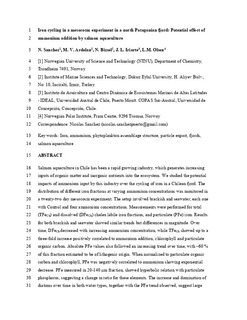| dc.contributor.author | Sanchez, Nicolas | |
| dc.contributor.author | Bizsel, Nyhayet | |
| dc.contributor.author | Iriarte, Jose Luis | |
| dc.contributor.author | Olsen, Lasse Mork | |
| dc.contributor.author | Ardelan, Murat Van | |
| dc.date.accessioned | 2020-01-09T11:53:41Z | |
| dc.date.available | 2020-01-09T11:53:41Z | |
| dc.date.created | 2019-04-26T09:40:45Z | |
| dc.date.issued | 2019 | |
| dc.identifier.citation | Estuarine, Coastal and Shelf Science. 2019, 220 209-219. | nb_NO |
| dc.identifier.issn | 0272-7714 | |
| dc.identifier.uri | http://hdl.handle.net/11250/2635518 | |
| dc.description.abstract | Salmon aquaculture in Chile has been a rapidly growing industry, generating increasing inputs of organic matter and inorganic nutrients into the ecosystem. We studied the potential impacts of ammonium input by this industry on the cycling of iron (Fe) in a Chilean fjord. The distribution of different Fe fractions at varying ammonium concentrations was monitored in a twenty-two day mesocosm experiment. The setup involved brackish water and seawater; each had a control and four ammonium concentrations. Measurements were performed for total (TFeCh) and dissolved (DFeCh) chelex labile Fe fractions, and particulate Fe (PFe). Results for both brackish and seawater showed similar trends but differences in magnitude. Over time, DFeCh decreased with increasing ammonium concentration, while TFeCh showed up to a three-fold increase positively correlated with ammonium addition, chlorophyll and particulate organic carbon. Overall, PFe values increased over time with 37%–89% of this fraction estimated to be of lithogenic origin. When normalized to particulate organic carbon and chlorophyll, PFe was negatively correlated with ammonium showing an exponential decrease. The PFe measured in the 20–140 μm fraction, showed a hyperbolic relationship with particulate phosphorus, suggesting a change in the ratio for these elements in this size fraction. The increase and dominance of diatoms over time in both water types, together with the observed PFe trend, suggest that large phytoplankton potentially act as the main carrier phase of potential scavenged Fe via the available surfaces of sinking cells. Positive correlations between changes in TFeCh and changes in chlorophyll and particulate organic carbon suggest a biological role in controlling the particulate labile Fe fraction, hence resulting in a potential increase of bioavailable Fe. Increasing ammonium addition in the fjords of Chile caused by salmon aquaculture may affect the phytoplankton assemblage composition and therefore the PFe to organic carbon ratio. Possible changes in biogeochemical Fe cycling may result from nutrient enhanced diatom-dominated blooms acting as more efficient vectors for downward export of organic matter. | nb_NO |
| dc.language.iso | eng | nb_NO |
| dc.publisher | Elsevier | nb_NO |
| dc.rights | Attribution-NonCommercial-NoDerivatives 4.0 Internasjonal | * |
| dc.rights.uri | http://creativecommons.org/licenses/by-nc-nd/4.0/deed.no | * |
| dc.title | Iron cycling in a mesocosm experiment in a north Patagonian fjord: Potential effect of ammonium addition by salmon aquaculture | nb_NO |
| dc.type | Journal article | nb_NO |
| dc.type | Peer reviewed | nb_NO |
| dc.description.version | acceptedVersion | nb_NO |
| dc.source.pagenumber | 209-219 | nb_NO |
| dc.source.volume | 220 | nb_NO |
| dc.source.journal | Estuarine, Coastal and Shelf Science | nb_NO |
| dc.identifier.doi | 10.1016/j.ecss.2019.02.044 | |
| dc.identifier.cristin | 1694074 | |
| dc.description.localcode | © 2019. This is the authors’ accepted and refereed manuscript to the article. Locked until 23.2.2021 due to copyright restrictions. This manuscript version is made available under the CC-BY-NC-ND 4.0 license http://creativecommons.org/licenses/by-nc-nd/4.0/ | nb_NO |
| cristin.unitcode | 194,66,25,0 | |
| cristin.unitname | Institutt for kjemi | |
| cristin.ispublished | true | |
| cristin.fulltext | preprint | |
| cristin.qualitycode | 1 | |

